-
- PCB TYPE
- PRINTED CIRCUIT BOARD PROTOTYPE ALUMINUM PRINTED CIRCUIT BOARD R&F PCB FPC HIGH FREQUENCY PCB HIGH-TG PCB HEAVY COPPER PCB HDI PCB PCB FOR LIGHTING METAL CORE PCB
time:Jun 28. 2025, 10:08:55
In the ever-evolving landscape of electronic manufacturing, Aluminum Printed Circuit Boards (PCBs) have emerged as a transformative technology, bridging the gap between thermal efficiency, mechanical robustness, and design versatility. Unlike traditional fiberglass-based PCBs, aluminum PCBs leverage the unique properties of aluminum as a substrate, offering unparalleled heat dissipation and structural integrity. This article provides a comprehensive exploration of aluminum PCBs, delving into their technical foundations, manufacturing processes, performance advantages, industry applications, and the future trends shaping their evolution. As electronics continue to demand higher power densities and compact designs, aluminum PCBs stand at the forefront of innovation, enabling sustainable and reliable solutions across diverse sectors.
Technical Foundations of Aluminum PCBs
Layered Structure and Material Synergy
Aluminum PCBs typically feature a three-layer architecture designed for optimal thermal and electrical performance:
Copper Circuit Layer: The top layer, responsible for electrical conductivity, is composed of high-purity copper foil. This layer is etched to form intricate circuitry, with thicknesses ranging from thin foils for low-current applications to thicker layers for high-power designs.
Thermally Conductive Dielectric Layer: Sandwiched between the copper and aluminum, this layer balances electrical insulation with thermal conductivity. Composed of ceramic-filled polymers or advanced composites, it ensures efficient heat transfer from components to the aluminum base while preventing short-circuits.
Aluminum Substrate: The core layer, providing mechanical support and thermal dissipation. Aluminum alloys are chosen for their high thermal conductivity (approximately 200-240 W/m·K) and lightweight properties, with common grades including 1050, 3003, and 5052 series, each offering specific advantages in corrosion resistance and formability.
Thermal Management Capabilities
The defining feature of aluminum PCBs is their exceptional thermal performance:
Heat Dissipation Mechanism: Unlike traditional PCBs where heat accumulates in the dielectric, aluminum PCBs transfer heat through the dielectric to the aluminum substrate, which acts as a heat sink. This reduces hotspots and maintains lower operating temperatures for components, extending their lifespan and reliability.
Thermal Resistance Reduction: The combination of a thermally conductive dielectric and aluminum base significantly lowers thermal resistance (Rth) between components and the environment. This allows for higher power densities without compromising performance, making aluminum PCBs ideal for high-power applications.
Mechanical and Electrical Properties
Mechanical Robustness
Aluminum substrates offer:
High Flexural Strength: Withstanding mechanical stress, vibrations, and impacts, making them suitable for harsh environments.
Dimensional Stability: Maintaining shape and integrity across a wide temperature range, critical for applications with thermal cycling.
Lightweight Design: Aluminum’s low density (2.7 g/cm³) enables lightweight PCBs, essential for portable and aerospace applications.
Electrical Considerations
Electrical Insulation: The dielectric layer ensures adequate insulation between the copper circuitry and aluminum substrate, with volume resistivity typically exceeding 10¹² Ω·cm.
Signal Integrity: While aluminum itself is conductive, proper design ensures the substrate does not interfere with high-frequency signals, making aluminum PCBs suitable for a range of electronic applications.
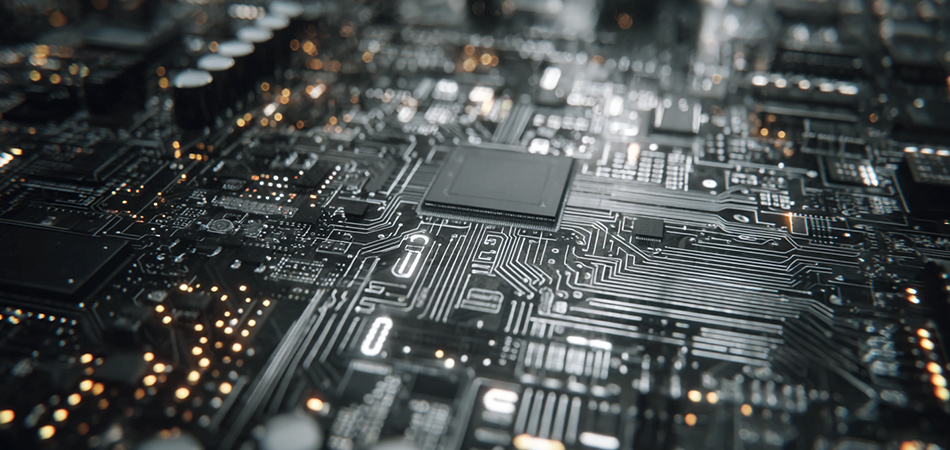
Manufacturing Processes for Aluminum PCBs
Material Preparation and Lamination
Substrate and Foil Selection
Aluminum Substrate Pretreatment: Surface cleaning and passivation to remove contaminants and enhance adhesion of the dielectric layer. Chromate-free conversion coatings (zirconium or titanium-based) are often used for environmental compliance.
Copper Foil Preparation: High-purity copper foils (electrolytic or rolled annealed) are selected based on thickness and conductivity requirements.
Dielectric Lamination
Prepreg Lamination: Thermally conductive prepregs (impregnated with resin and ceramic fillers) are sandwiched between the copper foil and aluminum substrate.
Hot Pressing: The assembly is subjected to controlled heat (150-200°C) and pressure (5-10 MPa) to cure the resin, forming a solid laminate. Vacuum lamination is often used to minimize voids and ensure uniform thickness.
Circuit Patterning and Component Integration
Photolithography and Etching
Photoresist Application: A light-sensitive resist is applied to the copper foil, followed by exposure through a mask and development to define the circuit pattern.
Copper Etching: Using eco-friendly etchants like ammonium persulfate, the unprotected copper is removed, leaving the desired circuitry.
Drilling and Vias
Precision Drilling: CNC machines with diamond-coated bits drill holes for component mounting, vias, and mechanical fasteners. Coolants are used to prevent overheating and burr formation.
Via Formation: Through-holes are plated with copper to establish electrical connections between layers in multi-layer PCBs, or filled with thermal vias to enhance heat dissipation.
Surface Finishing and Quality Control
Surface Finishes
Lead-Free Solder Finishes: Tin-based alloys (e.g., Sn-Cu, Sn-Ag-Cu) comply with RoHS regulations, ensuring solderability and corrosion resistance.
Electroless Nickel Immersion Gold (ENIG): Provides a smooth, uniform surface for fine-pitch components and excellent oxidation resistance.
Organic Solderability Preservative (OSP): A thin organic coating that protects copper surfaces while allowing easy soldering.
Quality Assurance
Dimensional Inspection: Using optical comparators and CMMs to verify hole positions, trace widths, and board thickness.
Thermal Testing: Thermal imaging and resistance measurements to ensure proper heat dissipation.
Electrical Testing: Continuity, insulation resistance, and dielectric breakdown voltage tests to validate electrical performance.
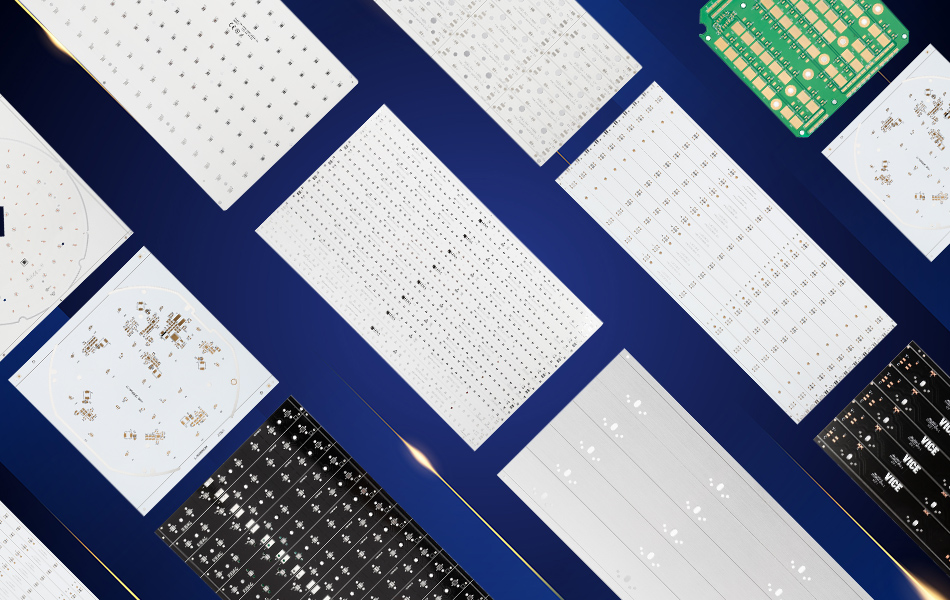
Advantages of Aluminum PCBs over Traditional PCBs
Superior Thermal Management
Reduced Thermal Resistance: Aluminum PCBs can dissipate heat up to 10 times more efficiently than FR-4 PCBs, making them ideal for high-power components like LEDs, power transistors, and voltage regulators.
Component Longevity: Lower operating temperatures extend component lifespan by reducing thermal stress and degradation.
Mechanical Strength and Durability
Resistance to Physical Stress: Aluminum’s mechanical properties allow PCBs to withstand vibrations, shocks, and bending without damage, suitable for automotive, aerospace, and industrial applications.
Thermal Cycling Stability: Maintains structural integrity through repeated temperature changes, critical for devices operating in fluctuating environments.
Design Flexibility and Space Optimization
Compact Form Factors: The thermal efficiency of aluminum PCBs eliminates the need for external heat sinks, enabling smaller, lighter designs.
Multi-Layer Capability: Supports complex multi-layer configurations for high-density applications while maintaining thermal performance.
Environmental and Cost Benefits
Recyclability: Aluminum is highly recyclable, contributing to sustainable manufacturing practices.
Long-Term Cost Savings: Reduced need for additional cooling systems and improved component reliability lower overall lifecycle costs, offsetting higher initial manufacturing expenses.
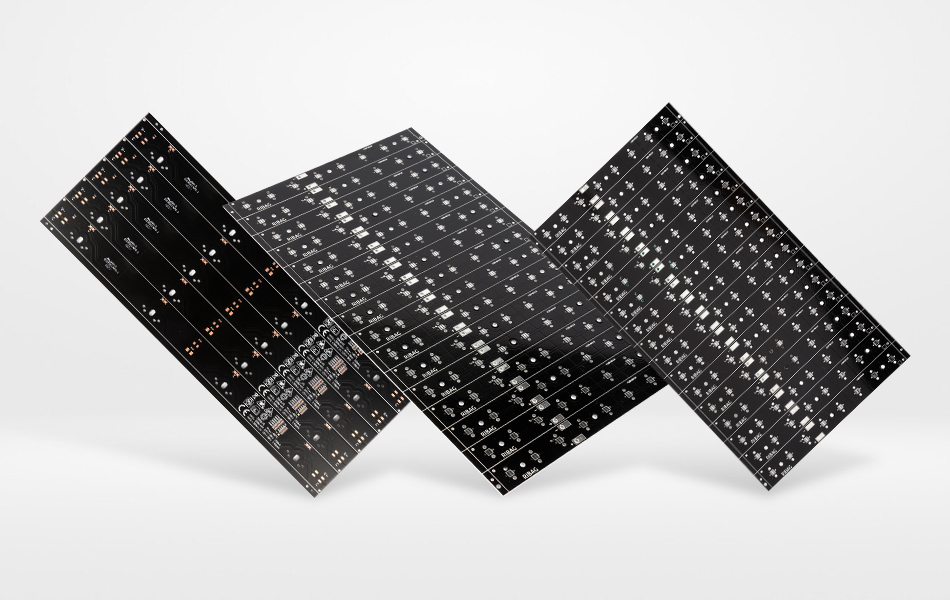
Industry Applications of Aluminum PCBs
Lighting Industry: Illuminating Efficiency
High-Power LED Lighting
Street Lighting: Aluminum PCBs enable bright, energy-efficient LED streetlights with long lifespans, reducing maintenance costs.
Commercial and Industrial Lighting: High-bay lights, floodlights, and architectural lighting systems benefit from efficient heat dissipation, ensuring consistent brightness and color quality.
Automotive Lighting: Headlights, taillights, and interior lighting in vehicles, where vibrations and temperature fluctuations are common.
Power Electronics: Managing High Energy Demands
Power Supplies and Inverters
Switching Power Supplies: Aluminum PCBs handle the heat generated by high-frequency switching components, improving efficiency and reliability.
Solar Inverters: Convert DC power from solar panels to AC, with aluminum PCBs dissipating heat from high-power semiconductors.
EV Charging Infrastructure: Fast chargers and charging station electronics require robust thermal management, provided by aluminum PCBs.
Consumer Electronics: Balancing Performance and Portability
Mobile Devices and Wearables
5G Smartphones: Aluminum PCBs cool high-power 5G modems, processors, and camera modules in slim devices.
Laptops and Tablets: Support powerful CPUs and GPUs while maintaining thin profiles for portable use.
Wearable Technology: Flexible aluminum PCBs in smartwatches and health monitors, combining thermal efficiency with comfort.
Automotive and Transportation: Reliability in Harsh Environments
Electric Vehicles (EVs)
Battery Management Systems (BMS): Monitor and control battery packs, with aluminum PCBs dissipating heat from battery cells.
Inverter and Motor Control: Manage high-voltage power conversion in EV drivetrains, ensuring safe and efficient operation.
Charging Systems: On-board chargers and DC-DC converters for EVs, requiring robust thermal management.
Traditional Automotive Electronics
Engine Control Units (ECUs): Withstand high temperatures and vibrations in engine compartments.
Advanced Driver Assistance Systems (ADAS): Support sensors and processors for autonomous driving features.
Medical Devices: Precision and Reliability
Healthcare Equipment
Diagnostic Instruments: Aluminum PCBs ensure stable operation of medical imaging devices and analytical equipment.
Implantable Devices: Miniature aluminum PCBs in pacemakers and insulin pumps, combining biocompatibility with thermal efficiency.
Wearable Medical Monitors: Flexible designs for continuous health tracking, with reliable thermal management.
Industrial and Aerospace: Extreme Environment Solutions
Industrial Automation
Robotics and Control Systems: Withstand dust, moisture, and mechanical stress in manufacturing environments.
Renewable Energy Systems: Wind turbine controllers and industrial solar inverters, requiring high reliability.
Hazardous Environment Equipment: PCBs for oil & gas, mining, and chemical processing, designed for flame retardancy and corrosion resistance.
Aerospace and Defense
Avionics Systems: Lightweight aluminum PCBs for aircraft navigation, communication, and control systems.
Satellite Electronics: Low-outgassing materials suitable for vacuum environments and extreme temperature variations.
Defense Electronics: Ruggedized PCBs for military applications, ensuring performance in harsh operational conditions.
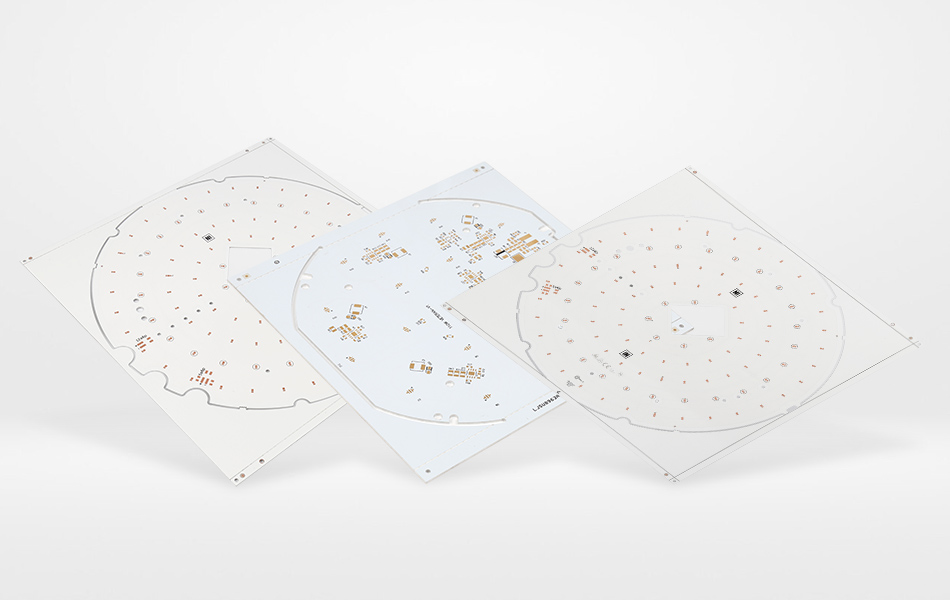
Design Considerations for Aluminum PCBs
Thermal Design Principles
Thermal Via Placement: Strategic placement of vias to direct heat from high-power components to the aluminum substrate.
Copper Pour Optimization: Using large copper areas (ground planes) to spread heat and improve thermal conductivity.
Component Layout: Grouping high-power components to facilitate efficient heat dissipation and avoid thermal hotspots.
Electrical Design Considerations
Clearance and Spacing: Maintaining adequate distance between high-voltage traces and the aluminum substrate to prevent arcing.
Signal Integrity: Proper routing and shielding for high-frequency signals to minimize interference from the aluminum base.
Grounding Strategies: Effective grounding techniques to ensure stable electrical performance and reduce noise.
Mechanical Design Factors
Board Thickness: Choosing the appropriate aluminum substrate thickness based on mechanical strength and thermal requirements.
Mounting and Fastening: Designing for secure component mounting, considering vibration and thermal expansion.
Edge Treatment: Rounding or coating board edges to prevent damage and improve handling.
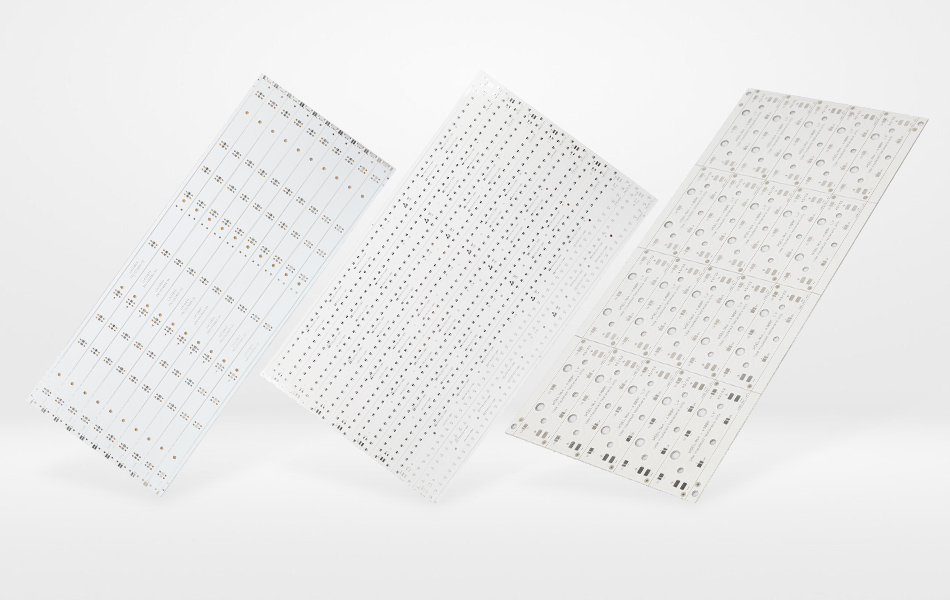
Challenges and Solutions in Aluminum PCB Implementation
Manufacturing Complexity and Cost
Challenge: Higher manufacturing costs compared to FR-4 PCBs due to specialized materials and processes.
Solution: Economies of scale, process optimization, and design for manufacturability (DFM) to reduce production costs.
Electrical Insulation Limitations
Challenge: Dielectric layers in aluminum PCBs have lower electrical insulation than some traditional materials.
Solution: Advanced dielectric formulations with improved insulation properties and careful design to avoid high-voltage applications where necessary.
Thermal Expansion Mismatch
Challenge: Different thermal expansion coefficients between copper, dielectric, and aluminum can cause stress and delamination.
Solution: Selecting materials with matched coefficients and implementing stress-relief designs, such as flexible dielectric layers or thermal vias.
Design Expertise Requirement
Challenge: Designing aluminum PCBs requires specialized knowledge of thermal and mechanical considerations.
Solution: Training and education for designers, along with the use of advanced CAD tools and thermal simulation software.
Future Trends in Aluminum PCB Technology
Advanced Material Innovations
Nano-Composite Dielectrics: Incorporating nanomaterials like graphene or boron nitride to enhance thermal conductivity and electrical insulation.
Biodegradable and Sustainable Materials: Development of eco-friendly dielectrics derived from renewable resources.
Metal Matrix Composites: Combining aluminum with ceramic fillers to create substrates with tailored thermal and mechanical properties.
Manufacturing Process Improvements
Additive Manufacturing (3D Printing): Enabling rapid prototyping and customized aluminum PCBs with reduced material waste.
Laser Processing: Precision laser drilling and etching for microvias and fine-line traces in high-density boards.
Automation and AI: Smart manufacturing systems for predictive maintenance, quality control, and process optimization.
Integration with Emerging Technologies
5G and 6G Communications: Low-loss aluminum PCBs for high-frequency antenna modules and base stations.
Artificial Intelligence and Edge Computing: High-power, high-density PCBs for AI accelerators and data centers.
Quantum Computing: Ultra-reliable aluminum PCBs for quantum bit control and cryogenic applications.
Circular Economy Initiatives
Design for Recycling: Aluminum PCBs designed for easy disassembly and material recovery.
Closed-Loop Manufacturing: Recycling aluminum and copper from end-of-life PCBs for new production.
Product-as-a-Service Models: Leasing PCBs to ensure proper maintenance and recycling at the end of their lifecycle.
Conclusion
Aluminum PCBs have revolutionized electronic manufacturing by combining exceptional thermal management, mechanical robustness, and design flexibility. From high-power LED lighting to advanced EV systems and cutting-edge medical devices, their applications continue to expand across industries. As technology progresses toward smaller, more powerful, and sustainable electronics, aluminum PCBs will play an increasingly critical role. Overcoming challenges in material science, manufacturing, and design, while embracing emerging trends, will further enhance their capabilities. The future of aluminum PCBs is rooted in innovation that balances performance with environmental responsibility, making them an indispensable foundation for the next generation of high-performance electronics.

Got project ready to assembly? Contact us: info@apollopcb.com



We're not around but we still want to hear from you! Leave us a note:

Leave Message to APOLLOPCB
